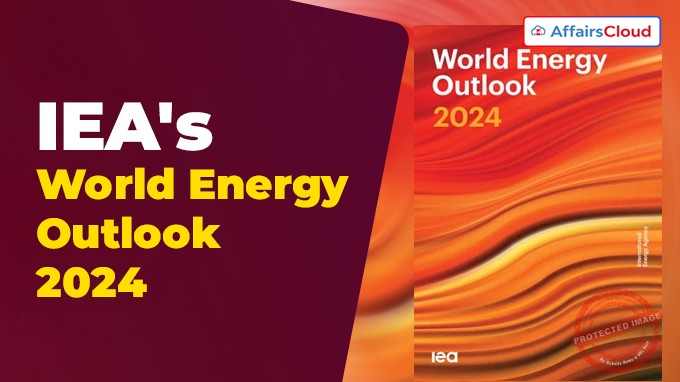 The International Energy Agency’s (IEA) has released its flagship report titled ‘World Energy Outlook (WEO 2024)’. It states that India is on track to become the third-largest economy in the world by 2028.
The International Energy Agency’s (IEA) has released its flagship report titled ‘World Energy Outlook (WEO 2024)’. It states that India is on track to become the third-largest economy in the world by 2028.
About World Energy Outlook(WEO):
The WEO, which has been published as an annual report since 1998. It provides global source of energy analysis and projections.
- It describes and assesses the biggest trends in energy demand and supply, as well their impact on energy security, emissions and economic development.
- This year’s report primarily focuses upon the increasing risks in the Middle East and enhanced global geopolitical tensions, and identifies a variety of energy security issues that decision makers deal with during the clean energy transitions.
- The report, based on present policies, projects that the world is set to enter a new energy market context in the coming years, marked by continued geopolitical hazards but also by a relatively abundant supply of multiple fuels and technologies.
Theme WEO 2024:
i.Energy security in relation to increased risks in the Middle East
ii.Prospects for clean energy transitions which are to be accelerated
iii.Ever present factor of Uncertainty
Scenarios for the future of global energy:
1.Stated Policies Scenario (STEPS): This scenario assumes that governments implement the energy policies that have already been announced.
2.Accelerated Policy Scenario (APS): This scenario assumes that governments implement more ambitious energy policies in order to achieve climate and other goals.
3.Net Zero Emissions by 2050 (NZE): This scenario assumes that global energy-related CO2 emissions reach net zero by 2050, in line with the Paris Agreement.
Highlights of WEO 2024:
i.TheWEO 2024 highlighted that the global energy system is weak and heightened by regional conflicts and geopolitical tensions.
ii.According to the report, excess supply of oil and natural gas in the latter half of this decade could reduce price pressures and provide opportunities clean energy investments.
- IEA also expects a relatively abundant supply of various fuels and technologies in the coming years, including oil, Liquified Natural Gas (LNG), solar photovoltaic(PV), and batteries.
iii.The report emphasized that the world is entering the Age of Electricity, with increased growth in global power demand, especially in China, where solar power generation could exceed the total electricity demand of the United States of America (USA) by the early 2030s.
- Electric Vehicles(EVs) projected to account for 50% of new car sales by 2030.
iv.Though there is progress in clean energy transitions, the report warned that current policies would result in a global temperature rise of 2.4°C by the end of the century, far above the Paris Agreement target of 1.5°C.
v.Clean energy investments have reached record highs, particularly in solar and wind power. In 2023 alone, over 560 gigawatts (GW) of renewable capacity was added globally, marking a significant leap towards reducing reliance on fossil fuels.
Global electricity demand:
i.Global electricity demand is on track to double by 2050, mainly due to China’s large scale energy transition, according to the Carbon Tracker’s statement on the IEA’s WEO 2024.
ii.The report states that while global growth in electricity demand is projected to accelerate to an average of 3.4% from 2024 through 2026.
- About 85% of the increase in the world’s electricity demand through 2026 is expected to come from outside advanced economies – most notably China, India and countries in Southeast Asia.
iii.Electricity generation from low-emissions sources comprising renewables, such as solar, wind and hydro, as well as nuclear power – should reduce the role of fossil fuels in providing power for homes and businesses.
- Low-emissions sources are expected to account for almost half of the world’s electricity generation by 2026, up from a share of just under 40% in 2023.
iv.Renewables are set to make up more than one-third of total electricity generation by early 2025, overtaking coal and by 2025, nuclear power generation is also projected to reach an all-time high globally due to increased commercial operations in countries like India, China, Japan, Europe and Korea.
v.In the IEA’s Net Zero Emissions by 2050 Scenario, a pathway aligned with limiting global warming to 1.5 °C, electricity’s share in final energy consumption nears 30% in 2030.
India faces higher increase in energy demand over next decade :
According to the WEO 2024, India is going to face a higher increase in energy demand than any other country over the next decade mainly because of its size and the scale of rising demand from all sectors.
i.India became the fastest growing economy with output increasing by 7.8% and is expected to become the third-largest economy in the world by 2028.
ii.Stated Energy Policy Scenarios (STEPS) based on current policy plans show that India is on track to add over 12,000 cars daily to its roads over the period to 2035.
- Built-up space is set to increase by over 1 billion square metres(m2) annually which is larger than the total built space in South Africa.
iii.The report showed that by 2035, iron and steel production in India are on track to grow by 70%. The cement output will increase by nearly 55%.
- The stock of Air Conditioners(AC) is projected to grow by over 4.5 times, leading to electricity demand from air conditioners in 2035 more than Mexico’s total expected consumption that year.
iv.As per the STEPS segment, the total energy demand in India is set to increase by nearly 35% by 2035 and electricity generation capacity to nearly triple to 1400 Gigawatt (GW). India set to have world’s 3rd largest installed battery storage capacity by 2030.
- Most of this power generation surge will be derived from coal. In 2023, coal met 40% of India’s power needs, while it is projected grow to more than 50% by 2035.
v.Nearly 60 GW of coal-fired capacity is projected to be added to the net of retirements by 2030. The electricity generation from coal will rise by over 15%.
- Generation from coal remains over 30% higher than that from solar Photovoltaic cells (PV) due to the lower capacity factor of solar installations.
vi.In Announced Pledges Scenario(APS), India’s commitment to achieve net zero emissions by 2070, clean power generation is nearly 20% higher than in the STEPS by 2035, and India has the world’s third-largest installed battery storage capacity in place by 2030 to accommodate the rising share of variable renewables.
India’s clean power generation is nearly 20% higher than in the STEPS by 2035, and has the world’s third-largest installed battery storage capacity in place by 2030 to accommodate the rising share of variable renewables for the mission to achieve Net Zero Emissions by 2070.
vii.The report also projected that a rapid rise in electric mobility is expected for India, which will lead to oil consumption peaking in the 2030s.
- Coal use in the industry will also rise in the 2030s as industrial use of electricity and hydrogen rises steadily.
- By 2035, India’s carbon dioxide(CO2) emissions will amount to 2.5 billion tonnes in 2035 which is 25% below the level in the STEPS.
About International Energy Agency (IEA):
Executive Director(ED) – Fatih Birol
Headquarters – Paris, France
Founded: 18 November 1974




